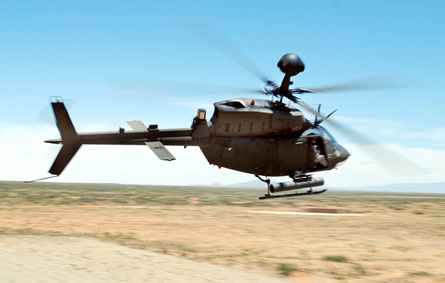After surviving two attempts to field a replacement scout helicopter, the Bell Helicopter OH-58D Kiowa Warrior is only getting stronger as the US Army considers a wide range of options for its future.
The Kiowa Warrior assumed a starring role on the service's biggest stage - the annual convention of the Association of the US Army. Service officials revealed a new "Fox" model called the OH-58F, featuring long-awaited cockpit and sensor upgrades for its 26-year-old scout helicopter fleet.
The army also announced that Bell is resuming a production line for Kiowa Warrior conversions that has lain dormant for about 15 years. The goal is to replace 43 OH-58Ds lost in accidents and combat since 2003 with remanufactured aircraft.
|
|---|
An ongoing analysis of alternatives, commissioned in the wake of the 2007 cancellation of the Bell ARH-70 Arapaho armed reconnaissance helicopter, is setting the course for the future of the army's scout helicopter fleet.
Army officials decline to release any new preliminary findings, but confirm that a solely unmanned solution has been ruled out.
When the study is complete in the second quarter of next year, army planners could still point in any of several directions. One option is to launch a new development programme for a high-speed aircraft, with the newly unveiled Sikorsky S-97 Raider as a top candidate.
Another option is to park the Kiowa Warrior fleet for an off-the-shelf aircraft that can meet the army's most demanding new requirement for so-called "high-hot" capability.
In mountainous Afghanistan, the OH-58D lacks enough power to fly missions when hovering out of ground effect at 6,000ft (1,830m) on a 35°C (95°F) day.
EADS North America and Lockheed Martin have teamed to adapt the UH-72 Lakota utility helicopter into an armed scout. Three of the AAS-72X demonstrators are now in development. AgustaWestland, meanwhile, would offer a militarised variant of its AW119.
But the army may decide to capitalise on its current investments in the OH-58D, which include integrating a digitally based glass cockpit and a nose-mounted Raytheon common sensor payload.
However, as the OH-58D fails to meet the new standard for high-hot performance, Bell is proposing to replace its Rolls-Royce Model 250-CR30 engine with Honeywell's HTS900-2: a 50% more powerful alternative leveraged from the cancelled ARH-70. R-R, however, has countered with an offer to increase the 250's thrust by up to 12%.
If preserving the OH-58D is the army's preferred approach, it also can look at an offer from AVX, a Texas-based start-up founded by mostly former Bell engineers.
AVX is proposing to transform the OH-58D into a compound helicopter with about 25% greater speed. The development could be made at a fraction of the cost of Bell's re-engining programme, AVX claims.
Source: Flight International
























